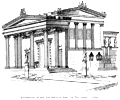Erechthēum
(
Ἐρέχθειον). The original sanctuary of the tutelary
deities of Athens, Athené Polias (the goddess of the city), Poseidon, and
Erechtheus. It was situated on the Acropolis. The old temple, said to have been built by
Erechtheus, was burned by the Persians in B.C. 480. The restoration was perhaps begun as far
back as the time of Pericles, but, according to the testimony of an inscription preserved in
the British Museum was still unfinished in 409. The new temple was, even in antiquity, admired
as one of the most
 |
|
Restoration of the Erechtheum from the Northeast. (Reber.)
|
beautiful and perfect works of the Attic-Ionic style. It was sixty-five feet long
and nearly thirtysix broad, and was divided into two main parts. Entering through the eastern
portico of six Ionic pillars, one came into the
cella of
Athené Polias, with an image of the goddess, and a lamp that was always kept
burning. To the solid wall at the back was attached the Erechtheum proper. Here were three
altars, one common to Poseidon and Erechtheus, the other to Hephaestus and the hero Butes.
Connected with this, by three doors, was a small front chamber, with seven half-columns
adorning the western wall, and three windows between them. This chamber was approached through
a hall attached to the north side of the temple, adorned with seven Ionic columns in front,
and one on each side. Under this was a cleft in the rock, said to have been made by the stroke
of Poseidon's trident during his contest with Athené for the
possession of the Acropolis. Corresponding to this on the south side was a small hall,
supported not by pillars, but by caryatides. This was called the Hall of Coré, and
it probably contained the tomb of Cecrops. From it a step led down to a court, once walled
round, in which were the Pandroseum (see
Pandrosos), the sacred olive-tree of Athené, and the altar of Zeus Herkeios.
On the east side, in front of the temple of Athené Polias, stood the altar on which
the great hecatomb was offered at the Panathenaea. See plan under
Acropolis.





